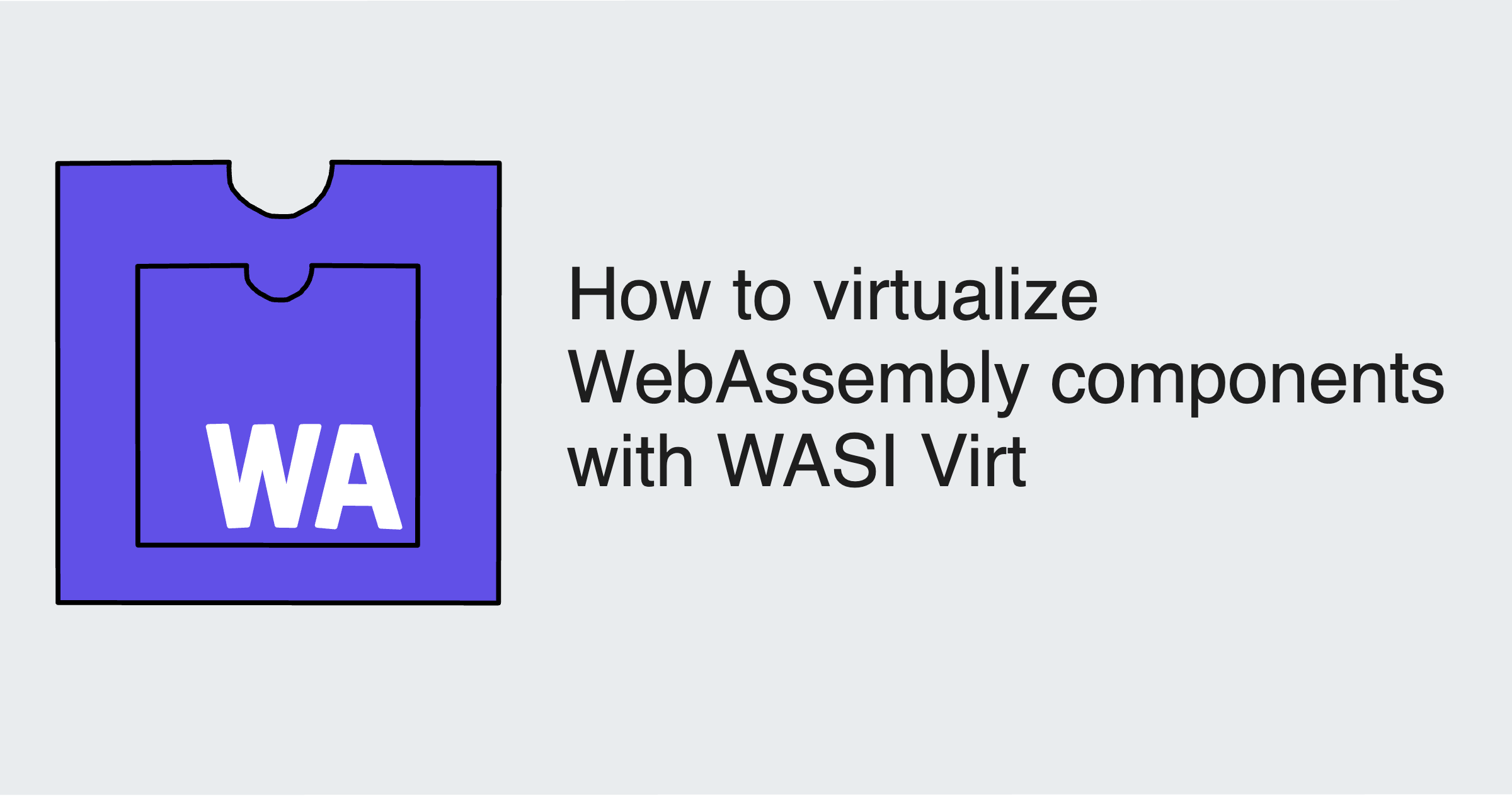
Cross-posted from the wasmCloud blog.
Suppose you're developing an application as a WebAssembly component, and you need access to environment variables—but your app will run in an environment where this is impossible. What do you do? The WebAssembly ecosystem provides a powerful command-line tool for this and similar use-cases called WASI Virt, enabling you to encapsulate components within other components and abstract away requirements, or otherwise consolidate your application.
In this blog, we'll explore how component virtualization works, when you might want to use WASI Virt, and how to get started.
How component virtualization works
For those new to the WebAssembly component space, a quick review: components are WebAssembly binaries adhering to an additional layer of specification called the Component Model. Like ordinary WebAssembly binaries, components are sandboxed and hyper-efficient. The Component Model enables them to go a step further and interoperate—regardless of the language they were originally written in—over standard APIs like the WebAssembly System Interface (WASI).
Along with portability and cross-language interoperability, composability is a signature feature of components: two or more components can be combined (or "composed") together into one standalone binary, with the constituent components satisfying one another's dependencies and exposed functions, or "imports" and "exports" respectively.

It's this characteristic that makes it possible to compose a component within an encapsulating component—in other words, to create a "virtualized component" for which all imports are satisfied, the external requirements abstracted away. In our case, if the requirement we need to abstract away is access to environment variables, we can compose our primary component with an encapsulating component that fulfills the need.
When to virtualize a component
Perhaps the most important use-case for WASI Virt and component virtualization is creating a sandbox to use sensitive functionality in secure environments.
In addition to environment variables, WASI Virt can give a component access to a virtualized filesystem, sockets, or stdio. This is an important use-case on wasmCloud, where interfaces like wasi:sockets are not available in accordance with a Zero Trust security model.
Here's the complete list of WASI interfaces that can be virtualized with WASI Virt:
- Clocks
- Environment
- Exit
- Filesystem
- HTTP
- Random
- Sockets
- Stdio
Beyond requirements for running in secure environments, it's useful to remember that virtualization with WASI Virt is a form of build-time composition, and this makes sense for some use-cases more than others, as well as lending itself more and less ideally to certain development workflows:
- Components that are composed together at build-time are tightly coupled and will generally be updated simultaneously, and will scale together once deployed. I
- If this doesn't make sense for your application, and you don't require an otherwise unavailable core operation system interface, it may make sense to explore dynamically linking components at runtime.
But returning to our original example: what if we need WASI Virt to make use of environment variables? Let's take a look at exactly how we can do it.
Example: Virtualized environment variables
We need access to environment variables, so we're going to use WASI Virt to give us access to this sensitive interface via an encapsulating component.
Before we get started, we need local installations of WASI Virt and wasmCloud Shell (wash). WASI Virt requires the nightly release channel for Rust:
rustup toolchain install nightly
Install the wasi-virt CLI tool with cargo:
cargo +nightly install --git https://github.com/bytecodealliance/wasi-virt
The example files are included in the wasmCloud monorepo. Perform a "sparse" checkout to download only the directory for this example:
git clone --depth 1 --no-checkout https://github.com/wasmCloud/wasmCloud.git
cd wasmcloud
git sparse-checkout set ./examples/rust/composition
git checkout
cd examples/rust/composition
For this example, we only need the pong directory.
Virtualizing a component
Change directory to the pong folder. In this directory is the code for a Rust component with a custom interface called pong that will return a string "ping" on its exported pingpong interface. Build the component:
cd pong
wash build
Use wash inspect to look at the WebAssembly Interface Type (WIT) interfaces used by this component:
wash inspect --wit ./build/pong_s.wasm
package root:component;
world root {
import wasi:cli/environment@0.2.0;
import wasi:cli/exit@0.2.0;
import wasi:io/error@0.2.0;
import wasi:io/streams@0.2.0;
import wasi:cli/stdin@0.2.0;
import wasi:cli/stdout@0.2.0;
import wasi:cli/stderr@0.2.0;
import wasi:clocks/wall-clock@0.2.0;
import wasi:filesystem/types@0.2.0;
import wasi:filesystem/preopens@0.2.0;
import wasi:random/random@0.2.0;
export example:pong/pingpong;
}
The pingpong interface is listed as an export and wasi:cli/environment is among the imports.
Now we can use WASI Virt to compose the pong_s.wasm binary into an encapsulating component with an environment variable PONG set to virtualized. Our new, composed component will be named virt.wasm.
wasi-virt build/pong_s.wasm --allow-random -e PONG=virtualized -o virt.wasm
Let's pause a moment to break down the command:
- The starting component is specified as
build/pong_s.wasm - The
--allow-randomargument allows the final component to importwasi:random/random(since the wasmCloud host satisfies that requirement) - The
-eargument sets an environment variablePONGtovirtualized - The output component is named
virt.wasm
Check out the interfaces for the new virtualized component:
wash inspect --wit virt.wasm
package root:component;
world root {
import wasi:random/random@0.2.0;
export example:pong/pingpong;
}
The new component exports pingpong but no longer imports wasi:cli/environment—that requirement has been abstracted away. If we run this component on wasmCloud, the host will be able to satisfy the random import—it will simply require another component to invoke it via the pingpong interface.
In the http-hello2 directory is a modified http-hello-world component that imports the pingpong interface and calls for a string from pong to append to the hello world message. Navigate to that directory and build the component.
cd ../http-hello2
wash build
The wadm.yaml application deployment manifest in this directory can be used to launch both the virtualized pong component and the new http-hello-world component. When we deploy with this manifest, wasmCloud will automatically link the components at runtime, so that pong can satisfy the import of http-hello-world.
wash app deploy wadm.yaml
If you invoke http-hello-world via curl, it invokes pong:
curl localhost:8080
Hello World! I got pong virtualized
We get the environment variable value virtualized back in the hello world message. Virtualization achieved!
Conclusion
For more information on using WASI Virt, see the project repository on GitHub. If you'd like to talk about virtualizing components and building applications on wasmCloud, join us on the wasmCloud community Slack!
